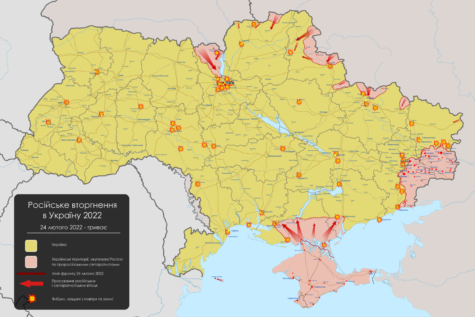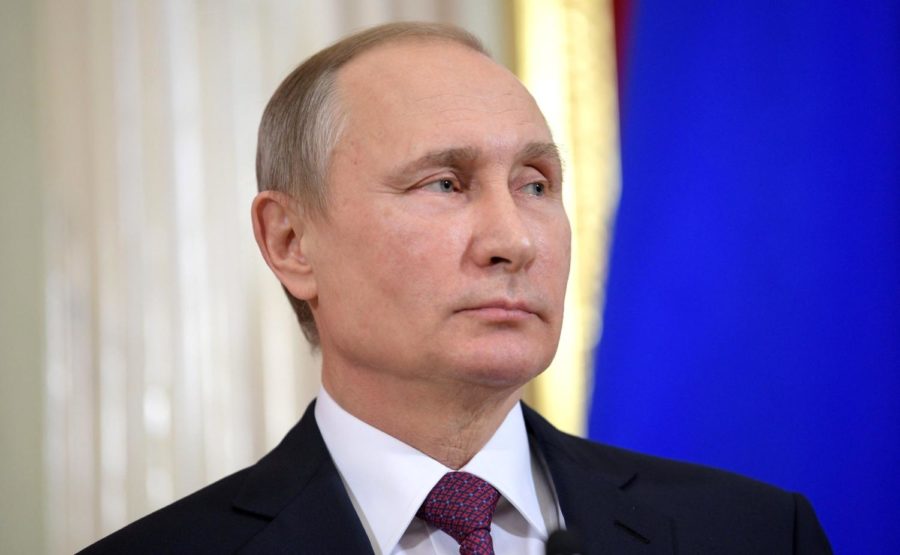War surges between Russia and Ukraine
Vladimir Putin, Russias current president, has openly stated he does not recognize Ukraine as an independent nation.
On Thursday, Feb. 24, Vladimir Putin, Russia’s current president, invaded the eastern European country Ukraine after weeks of unrest. The two countries have had a tumultuous relationship for years, but the tensions recently escalated when Putin sent soldiers into Ukraine in response to the North Atlantic Treaty Organization (NATO)’s presence in the eastern European countries.

The conflict between Russia and Ukraine dates back many decades, but the beginning of this particular conflict started in 2014, when Russia annexed the Ukrainian peninsula Crimea. At the same time, rebels in the eastern Donbas region revolted against Ukraine in support of the Russian government. This conflict resulted in a violent war, where the Russian military sided with the rebels.
These internal affairs were just a few of the examples that led to the Feb. 24 invasion. This invasion, initiated by President Putin, first attacked Donbas, but as the days passed, the soldiers began making their war throughout other regions. The Russian troops are ultimately aiming to seize the capital, Kyiv.
In response to the invasion, Ukraine’s president, Volodymr Zelenskyy, has urged Ukranians to fight back and resist the attacks. This resistance, as it has been displayed all over social media the past few weeks, may lead to an even larger force of attack by Putin’s troops.
The cause of this unprecedented attack was ultimately Putin’s desire to remove all NATO influence in the eastern European region, or the former Soviet Union (USSR) states. Putin also stated that one of his demands is that Ukraine never be admitted to NATO, as the Russian president sees Russia and Ukraine as one country, not two.
There have been at least 352 reported Ukrainian deaths, 1,100 wounded, and an estimated 3,000 soldiers killed so far. As we continue to watch, more and more families are fleeing their hometowns to escape the attacks.
“This is the first time we have seen an invasion like this since the second world war,” said Naya Majauskas, junior.
As for the United States (U.S.), President Biden has made the country’s position clear. The U.S. government will continue to not interfere in the conflict but they will do their best to deescalate the situation. This position is controversial as many Americans believe the U.S. should do everything in their power to help, while others believe it is in their best interest to remain neutral.
“I think it is challenging right now to articulate a policy that would lead the US to intervene militarily,” said Daniel Otahal, from the Social Studies department. “There’s so much more complexity to the Russia situation.”
As of right now, the war is still ongoing. The current president of Belarus, Lukashenko, conducted a peace talk on Feb. 28th between Ukraine and Russia, though Zelensky is not optimistic about the effectiveness. While these peace talks were supposed to ultimately decrease tension, Russia continues to invade, having approached Ukraines capital Kyiv on Feb. 25.
“The worst case scenario is that this war drags on for a long time, and ends in a defeat for the Ukrainians.” said Nikolai Rhodes, Junior. “The best case scenario for Ukrainians is the Russians suing for peace right now, and gaining all their territory back, including Crimea which was taken in 2014, and the guaranteed compliance of the Russian rebels in Donbas.”
To read live updates on the ongoing conflict, visit https://www.nytimes.com/live/2022/02/27/world/russia-ukraine-war












